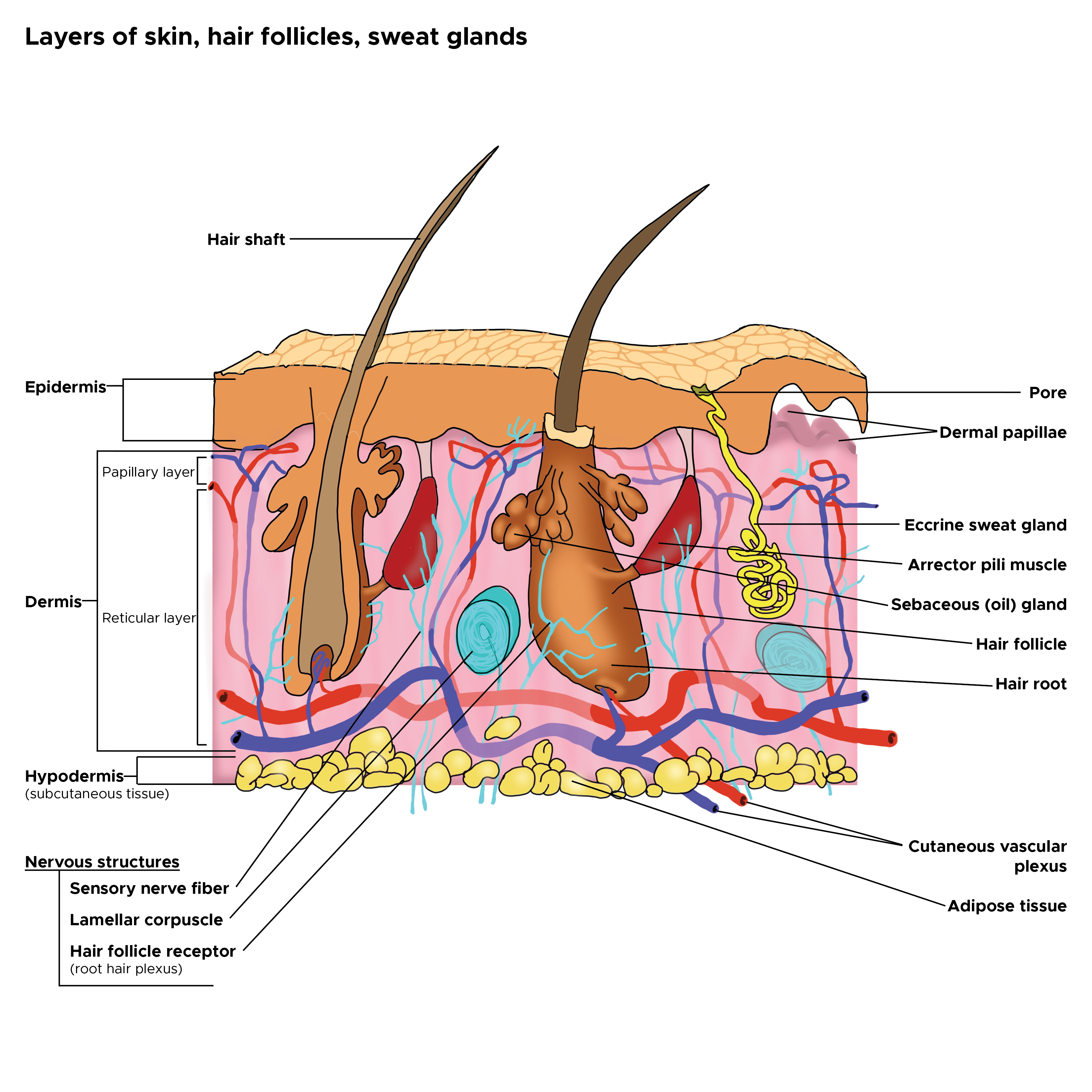[2]
Nawrocki S, Cha J. The etiology, diagnosis, and management of hyperhidrosis: A comprehensive review: Etiology and clinical work-up. Journal of the American Academy of Dermatology. 2019 Sep:81(3):657-666. doi: 10.1016/j.jaad.2018.12.071. Epub 2019 Jan 31
[PubMed PMID: 30710604]
[3]
Fulton EH, Kaley JR, Gardner JM. Skin Adnexal Tumors in Plain Language: A Practical Approach for the General Surgical Pathologist. Archives of pathology & laboratory medicine. 2019 Jul:143(7):832-851. doi: 10.5858/arpa.2018-0189-RA. Epub 2019 Jan 14
[PubMed PMID: 30638401]
[5]
Urso B, Lu KB, Khachemoune A. Axillary manifestations of dermatologic diseases: a focused review. Acta dermatovenerologica Alpina, Pannonica, et Adriatica. 2018 Dec:27(4):185-191
[PubMed PMID: 30564831]
[6]
Kabashima K, Honda T, Ginhoux F, Egawa G. The immunological anatomy of the skin. Nature reviews. Immunology. 2019 Jan:19(1):19-30. doi: 10.1038/s41577-018-0084-5. Epub
[PubMed PMID: 30429578]
[7]
Rittié L, Sachs DL, Orringer JS, Voorhees JJ, Fisher GJ. Eccrine sweat glands are major contributors to reepithelialization of human wounds. The American journal of pathology. 2013 Jan:182(1):163-71. doi: 10.1016/j.ajpath.2012.09.019. Epub 2012 Nov 14
[PubMed PMID: 23159944]
[8]
Balachander N, Masthan KM, Babu NA, Anbazhagan V. Myoepithelial cells in pathology. Journal of pharmacy & bioallied sciences. 2015 Apr:7(Suppl 1):S190-3. doi: 10.4103/0975-7406.155898. Epub
[PubMed PMID: 26015706]
[9]
Gagnon D, Crandall CG. Sweating as a heat loss thermoeffector. Handbook of clinical neurology. 2018:156():211-232. doi: 10.1016/B978-0-444-63912-7.00013-8. Epub
[PubMed PMID: 30454591]
[10]
Murota H, Yamaga K, Ono E, Katayama I. Sweat in the pathogenesis of atopic dermatitis. Allergology international : official journal of the Japanese Society of Allergology. 2018 Oct:67(4):455-459. doi: 10.1016/j.alit.2018.06.003. Epub 2018 Aug 3
[PubMed PMID: 30082151]
[11]
Benzecry V, Grancini A, Guanziroli E, Nazzaro G, Barbareschi M, Marzano AV, Muratori S, Veraldi S. Hidradenitis suppurativa/acne inversa: a prospective bacteriological study and review of the literature. Giornale italiano di dermatologia e venereologia : organo ufficiale, Societa italiana di dermatologia e sifilografia. 2020 Aug:155(4):459-463. doi: 10.23736/S0392-0488.18.05875-3. Epub 2018 Apr 19
[PubMed PMID: 29683279]
[12]
Wadhawa S, Agrawal S, Chaudhary M, Sharma S. Hyperhidrosis Prevalence: A Disease Underreported by Patients and Underdiagnosed by Physicians. Indian dermatology online journal. 2019 Nov-Dec:10(6):676-681. doi: 10.4103/idoj.IDOJ_55_19. Epub 2019 Nov 1
[PubMed PMID: 31807447]
[13]
Wang Y, Sun P, Leng X, Dong Z, Bi M, Chen Z. A new type of surgery for the treatment of bromhidrosis. Medicine. 2019 May:98(22):e15865. doi: 10.1097/MD.0000000000015865. Epub
[PubMed PMID: 31145340]
[14]
Perera E, Sinclair R. Hyperhidrosis and bromhidrosis -- a guide to assessment and management. Australian family physician. 2013 May:42(5):266-9
[PubMed PMID: 23781522]
[15]
Reddy MM,Stutts MJ, Status of fluid and electrolyte absorption in cystic fibrosis. Cold Spring Harbor perspectives in medicine. 2013 Jan 1;
[PubMed PMID: 23284077]
Level 3 (low-level) evidence
[16]
Chao K, Aleshin M, Goldstein Z, Worswick S, Hogeling M. Lamellar ichthyosis in a female neonate without a collodion membrane. Dermatology online journal. 2018 Feb 15:24(2):. pii: 13030/qt24g7w9t8. Epub 2018 Feb 15
[PubMed PMID: 29630152]
Level 3 (low-level) evidence
[17]
Napolitano M, Megna M, Timoshchuk EA, Patruno C, Balato N, Fabbrocini G, Monfrecola G. Hidradenitis suppurativa: from pathogenesis to diagnosis and treatment. Clinical, cosmetic and investigational dermatology. 2017:10():105-115. doi: 10.2147/CCID.S111019. Epub 2017 Apr 19
[PubMed PMID: 28458570]
[18]
Paramkusam G, Meduri V, Nadendla LK, Shetty N. Hereditary hypohidrotic ectodermal dysplasia: report of a rare case. Journal of clinical and diagnostic research : JCDR. 2013 Sep:7(9):2074-5. doi: 10.7860/JCDR/2013/5757.3409. Epub 2013 Sep 10
[PubMed PMID: 24179947]
Level 3 (low-level) evidence

